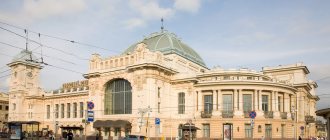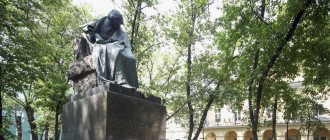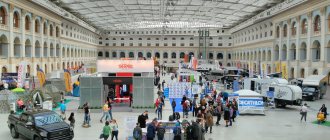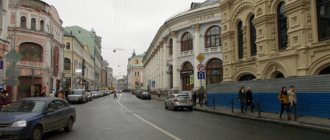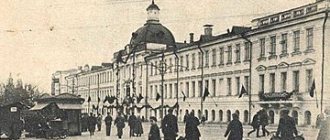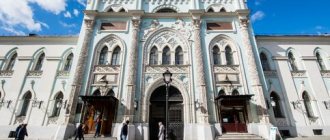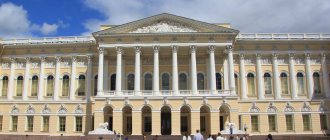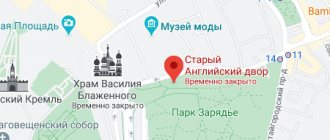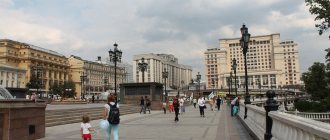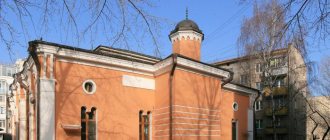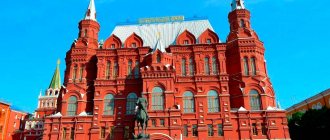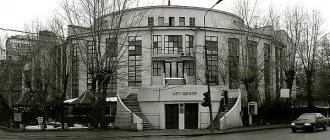Today it is the most famous and largest shopping building in Moscow. It serves not only as a decoration of the capital and an important monument to its history, but also as a modern shopping and business center. The architectural heritage, built at the turn of the 18th–19th centuries in the style of classicism, is located near Varvarka and Ilyinka - witnesses to the birth of one of the most interesting sights in Moscow.
After the last reconstruction carried out in the 1990–2000s, the area of the building, which became the center of cultural and business life of the city, increased to 82,000 sq.m.
Now it takes up an entire block. The historical complex was equipped with climate control and electronic control systems. Two floors and an attic were added to the southern wing, where representative offices and offices of famous companies settled. The premises of Gostiny Dvor house restaurants, bars, shops, cafes and beauty salons. The amphitheater, with a capacity of 450 seats, hosts city and state holidays, events for children, concerts and meetings. Gostiny Dvor hosts prestigious exhibitions (such as the doll exhibition and spring wedding exhibitions), fashion shows and summer alumni balls.
© NKleymenova
The heart of the complex is the Atrium, hidden under the largest dome in Europe. The spacious courtyard, covering 12,000 sq.m., is fenced with stucco columns and decorated with granite.
Shopping within the walls of Gostiny Dvor is as unusual and unforgettable as its architecture. It feels like you're walking through the central streets of a small European town, full of restaurants and shops, ice cream stands and cute shops. And most importantly, in order to change the atmosphere from the noisy, full of people of Moscow, to the comfort of the old days, you don’t even have to leave the city center.
Old Gostiny Dvor on Ilyinka
At the end of the 18th and beginning of the 19th centuries, Gostiny Dvor on Ilyinka was the largest commercial building in Moscow. Its design was developed by Giacomo Quarenghi. The architect lived in St. Petersburg and made the drawings there - according to the area plan that was sent to him. He did not take into account the strong slope of the ground in Kitai-Gorod, and in Moscow Quarenghi’s project was finalized by architects Semyon Karin and Ivan Selekhov. They built a building closed around the perimeter, its galleries were decorated with Corinthian semi-columns.
It was in Gostiny Dvor that the infamous Moscow fire of 1812 began; the building was badly damaged. Almost 30 years later it was rebuilt by Osip Bove. Gostiny Dvor was reconstructed several more times; today it bears little resemblance to Quarenghi’s work. Several floors were built here, and the courtyard was covered with a glass roof.
Construction
Market relations developed at a rapid pace, and many foreign merchants came to the capital. And by the end of the 18th century, the question of reconstructing the building again arose. After a long period of rain, one of the walls of the building collapsed, destroying part of the shops. The roof and towers were in disrepair. Catherine the Great advocated the development of trade relations within the empire, and understood the need to reconstruct Gostiny Dvor. But there were no funds for construction.
In 1786, Catherine issued a decree stating that the old building and the land underneath it would be sold piecemeal to merchants and shopkeepers. With the condition that they will be the collective owners of Gostiny Dvor. And the proceeds went towards the construction of a new commercial building. The construction project was developed by the architect Karin, but the empress approved the project of Giacomo Quarenghi, an architect from Italy. And in 1789 construction began. Quarenghi's project was thought out down to the smallest nuances. A rationally organized internal structure of the premises - more than 700 benches and a spacious courtyard were planned, which the building was divided into 2 parts. There were arches and semi-columns along the perimeter of the building, and the arcades in the courtyards were decorated with rich pilasters. In order to smooth out the external bulkiness of the building and relieve traffic on narrow streets, wide staircases were installed on rounded corners, according to the design.
But the Italian architect did not take into account the nuances of the area - clay soil and the difference in height between Varvarka and Ilyinka streets. Therefore, the project had to be finalized by Russian architects. The construction of Gostiny Dvor ended in 1805. It became a very popular public place; there were many shops, offices, and taverns. Many people visited Gostiny Dvor simply to exchange news. It is believed that the discounts on remaining goods, which are so popular now, began in the Moscow Gostiny Dvor. In 1923, the building of this famous Moscow shopping complex was converted into offices, and during the Great Patriotic War it was used as a bomb shelter. Throughout the 20th century, Gostiny Dvor slowly deteriorated, and by the 90s it completely fell into disrepair. The leadership of the capital decided to restore the historical monument.
Gostiny Dvor in Kaluga
Kaluga Gostiny Dvor was built at the end of the 18th century. The architectural ensemble consists of 14 buildings, three of which are connected by passages. The decor of the building combines elements of Baroque and pseudo-Gothic style. Who was the author of the project is still a controversial issue. Some researchers attribute it to local architect Pyotr Nikitin, others believe that the building was built by an architect from Moscow - perhaps even Vasily Bazhenov.
Notes
- ↑ 123456
The best building in all of Moscow. Moslenta (July 16, 2017). Retrieved June 16, 2021. - ↑ 12
Schmidt, 1997, p. 232. - Pylyaev, 2008, p. 461-462.
- ↑ 12
Gostiny Dvor: a pearl in the center of Moscow. Days.ru (March 30, 2018). Retrieved June 16, 2021. - ↑ 12
Romanyuk, 1988. - ↑ 123
Vostryshev, 2011, p. 209. - ↑ 123
Gostiny Dvor (reconstruction), Moscow. Archi.ru. Retrieved June 16, 2021. - Brodsky, 1987, p. 94.
- ↑ 123
Prokofieva, 2010, p. 41-46. - ↑ 123
Gostiny Dvor. Moscow.org. Retrieved June 16, 2021. - Sytin, 1972, p. 23.
- Aruin, 1998, p. 28.
- Now houses are being “restored” by removing air conditioners. Vedomosti (October 21, 2009). Retrieved June 16, 2021.
- The owner of the Shater trading house completely bought out Gostiny Dvor in Moscow. RBC (October 20, 2014). Retrieved June 16, 2021.
- Putin's election headquarters will be located in Gostiny Dvor. RBC (January 9, 2018). Retrieved February 7, 2021.
Gostiny Dvor in Tobolsk
Tobolsk Gostiny Dvor is one of the earliest monuments of commercial architecture. It was built according to the design of Semyon Remezov in 1703–1708 and combines ancient Russian architecture with oriental elements. In a closed square building with a courtyard and two entrance gates, in addition to commercial premises, there were warehouses and a hotel. In the middle of the 18th century, a court, a prison, several provincial institutions and a pharmacy were also located here. Above the gate were the customs premises and the chapel.
Modernity
Interior of Gostiny Dvor, 2015
Gradually, Gostiny Dvor deteriorated and collapsed: the foundation sank, cracks appeared. In 1996, its restoration began in accordance with Moscow government decree No. 618 of July 26, 1994, which lasted five years[6]. Archaeologists worked at the construction site, exploring the cultural layer from Ilyinka to Varvarka. They managed to discover about two hundred structures from the 12th to 17th centuries: residential and utility log buildings, drainage systems and wells. When clearing a deep log basement in the pits, a treasure was found containing 16 silver vessels, more than 95 thousand Russian silver coins and 335 thalers minted at the mints of Western Europe. They are exhibited in the archaeological museum of the Old Gostiny Dvor[10][7][9].
The work started was carried out without a thorough inspection of the building due to the tight deadlines. Initially, it was planned to complete the reconstruction by the 850th anniversary of Moscow. After the collapse of several arches during construction, the deadlines were shifted and the design team was replaced: the work was transferred to Workshop No. 15 of Mosproekt-2, led by Sergei Tkachenko. As a result of the reconstruction, attic floors were added and equipped for offices. The domed roof changed the panorama of Kitay-Gorod, which opens from the Bolshoi Moskvoretsky Bridge, and the gallery lost its view of St. Basil's Cathedral. The 12,000 m² courtyard was paved with granite and covered with a translucent structure. A team of engineers worked on its creation: V. A. Ilyin, I. A. Shukhnin, S. Yu. Kim, chief designers Nodar Kancheli and I. G. Eremeev[10][7][9]. According to some estimates, after reconstruction, the historical monument turned into a “dummy” characteristic of the Luzhkov period[13].
Since 2000, Old Gostiny Dvor has been managed by private companies. In 2014, 49% of the complex was bought by Premier Invest OJSC, headed by businessman Mikhail Mikhailovich Khubutia[4][14]. As of 2021, Gostiny Dvor belongs to the city and is managed by the Manege museum and exhibition association[15].
Small Gostiny Dvor in Kungur
A shopping complex of 12 shops in an eclectic style was built in 1874 with the money of the city mayor of Kungur, merchant Mikhail Gribushin. Maly Gostiny Dvor was built according to the design of the architect Nikolai Voskresensky and was initially called the Gribushinsky building after the name of the patron. The shops sold tea and sugar: in the 19th century, Kungur was considered the tea capital of Russia.
Today the shopping complex houses the Museum of the History of Merchants.
Spas in Gostiny Dvor
Inside the ensemble of shopping arcades in Kostroma there is the Spasskaya Church. A wooden church stood on this site back in the 17th century. It was rebuilt in stone in the middle of the 18th century at the expense of the merchant Stefan Belov. A few decades later, the architect Karl von Kler built Gostiny Dvor around the church, and it became part of the architectural ensemble.
Both the church and the shopping malls are still open today.
Moscow.org Moscow city portal
| All photos |
Address: st. Ilyinka, 4
How to get to Gostiny Dvor: st. metro station Ploshchad Revolyutsii
Old Gostiny Dvor is located in the center of Moscow, next to Red Square. Gostiny Dvor stretches over an entire block. Its main façade faces Ilyinka, two side facades face Rybny and Khrustalny alleys, and the fourth faces Varvarka. Varvarka and Ilyinka in the old days were part of Veliky Posad - part of the city located outside the Kremlin. The center of Posad was located next to the Moskvoretsky Bridge. Merchants with their goods arrived in this place from different parts of Rus' and from abroad; already in the 14th-15th centuries there was a lively retail and wholesale trade here. The entire coastal area and the eastern side of the Kremlin became the trade and craft center of Moscow. There were many shops here, including Nizhny ones. Middle, Upper shopping rows. When merchants were evicted from the Kremlin territory after a big fire in 1493 (apparently so that the accumulation of goods would not create a fire hazard), they settled where Red Square is now located. The busiest trade took place at the intersections of such shopping streets, “sacrums.” In the 16th century, the very first Gostintsy Dvor, built of wood, appeared on Ilyinsky Krestets. Here merchants traded and stored goods, and visitors stayed here.
In 1535, during the reign of Ivan the Terrible’s mother, Elena Glinskaya, a wall of Kitay-Gorod was built, covering a significant part of the settlement. Most of the buildings that ended up on the territory of Kitai-Gorod were commercial buildings. Later, under Ivan the Terrible, the wooden Gostiny Dvor was replaced with a stone one. During the Time of Troubles in the 16th century, Gostiny Dvor burned. It began to be restored during the reign of Mikhail Fedorovich Romanov, the first tsar of the Romanov family. After the Old Gostiny Dvor was rebuilt, they began construction of a new building, which was called the New Gostiny Dvor. Its construction was completed under Tsar Alexei Mikhailovich in 1661-1664. Both of these buildings occupied only part of the block. At the end of the 17th century, Gostiny Dvors included several dozen rows, which were called by the names of the goods: icon, candle, wax, hat, nut, honey, and so on. This separation of goods can be called the basics of hygiene in trade. Gostiny Dvor was full of people from dawn to dark; in order to get to the right place, you had to push through people.
At the end of the 18th century, the issue of another restructuring of Gostiny Dvor became relevant. Catherine the Great decided to strengthen the Russian economy by developing internal market relations. In 1786, the Empress issued a decree “On giving the stone Gostiny Dvor to the city to increase income for various needs,” and ordered the construction of a new Gostiny Dvor building. This decision was all the more justified, since in 1700 15 shops collapsed in Gostiny Dvor. The project of the new building was developed by Giacomo Quarenghi, who arrived in St. Petersburg from Bergamo, lived in Russia for several decades and made a significant contribution to the formation of the architectural face of St. Petersburg. The project was remarkable both in appearance and in the rationality with which the architect used the space. Along the entire perimeter of the building there were arches and Corinthian semi-columns of the large order. Taking into account the narrowness of the streets and their heavy traffic congestion, the architect rounded the corners of the building, incorporating wide staircases into them. The large courtyard was divided into two parts by a transverse building. The arcade on the side of the courtyards was decorated with Tuscan pilasters.
Construction of Gostiny Dvor lasted from 1789 to 1805. The work was supervised by the architects of the Moscow Deanery S. Karin, I. Egotov and P. Selikhov. During the construction of the new building, various difficulties arose. The fact is that in the Old Gostiny Dvor there were a total of 760 shops. All merchants, having received a building permit, bought land and built a shop, places were distributed spontaneously and simultaneously from different points, in some places they had already erected two floors, and in others one, others resold their places without starting construction. The difference in elevation at the construction site reached 8-10 fathoms, and the lack of sufficiently thorough elaboration of the project led to the fact that they built it as they pleased. The walls were different in height and did not fit together; instead of the Corinthian columns provided for by the project, columns in the Tuscan style were built. But, in the end, despite some distortions of the project, Gostiny Dvor can safely be considered one of Quarenghi’s most successful projects.
After the death of Catherine II, construction was suspended for some time. The first stage of Gostiny Dvor was completed in 1805, and Gostiny Dvor acquired its final form after the liquidation of the consequences of the Moscow fire of 1812, when the architect Osip Bove restored it according to Quarenghi’s drawings. The Gostiny Dvor building was completely completed in 1830.
Since Gostiny Dvor in Moscow was one of the first built in Russia, this project became a kind of model for the construction of similar structures in other cities. It was from Gostiny Dvor that the tradition of selling leftover goods at discounted prices began.
Whether this is true or not, it was said that one day one of the traders was returning home at the end of the day, and he was stopped by a raisin peddler, who had very little of the sweet product left. And although the merchant didn’t need the raisins, he succumbed to persuasion to buy the rest cheaper, hence the saying “leftovers are always sweet.” The merchant not only purchased raisins, he thought that he could sell the remains of various goods at a lower price, thereby attracting buyers. This merchant opened a new shop, business in which went very successfully. The speed of the idea was appreciated by the entire trading city of Moscow. Sales week was once a year. It began on St. Thomas Sunday and ended on the first Sunday after Easter. Even expensive fashion stores on Kuznetsky Most succumbed to this discount fever.
The service at that time was quite different from the current one; the principle “the buyer is always right” did not work, for example, if after much persuasion the buyer still refused to buy the product. They could simply hit him in the neck. There were frequent pranks among customers, when all the shopkeepers conspired and all as one claimed that the blue cloth was not actually blue, but, for example, green. In such cases, a desperate buyer, having visited all the shops, could leave with a product of the wrong color that he needed.
Gostiny Dvor in Moscow stood for almost 200 years, and was almost lost, like many other historical and architectural monuments. The last restoration of Gostiny Dvor was carried out in 1923, when its premises were adapted to accommodate various offices. During the Great Patriotic War of 1941, some of its premises were used as bomb shelters. Three arches were laid in the courtyard, and a factory was located inside the courtyard.
Gradually Gostiny Dvor began to deteriorate and collapse. Walls were deformed, foundations sagged, cracks appeared, and old brickwork decomposed. Groundwater also had a destructive effect on the foundation of the building. At the end of the 20th century, studies were carried out that showed that the building was in disrepair. On July 26, 1994, work began on the reconstruction and restoration of Gostiny Dvor. About 1,000 people took part in construction every day, and much of the work had to be done manually. In addition, the construction work was accompanied by archaeological research, which gave the city unique finds, including a storeroom complex that contained 16 vessels made of precious metals, more than 95 thousand Russian silver coins and 335 thalers minted at the mints of Western Europe from the Pyrenees to Scandinavia. The project by which Gostiny Dvor was renovated, and the entire reconstruction process, caused a mixed reaction among Moscow residents, historians and archaeologists, however, it was carried out and now we can see the renovated Old Gostiny Dvor in Kitay-Gorod.
During the restoration and reconstruction, in accordance with the “smart home” concept, the interior spaces were completely re-equipped, climate systems were introduced, creating conditions for connecting office equipment and control systems. Courtyard area of 12,000 sq.m. paved with granite and covered with a light, unsupported translucent ceiling. The coating has systems for snow melting, climatology, collection and removal of condensate. The current Gostiny Dvor is a large business and shopping center, the total area of the complex is 82,000 sq.m.
Historical reference:
16th century — the very first Gostintsy Dvor, built of 16th-century wood, appeared on Ilyinsky Krestets. – during the Time of Troubles, Gostiny Dvor burned 1661-1664. - the construction of the new building of the Gostiny Dvor was completed in 1786 - Empress Catherine II ordered the construction of a new building of the Gostiny Dvor in 1789-1805. a new building of Gostiny Dvor is being built (first stage) 1830 - the building of Gostiny Dvor is completely finished 1923 - restoration of Gostiny Dvor was carried out July 26, 1994 - work began on the reconstruction and restoration of Gostiny Dvor
Shopping arcades in Torzhok
The architectural complex of the Trading Rows took shape over the course of the 18th–19th centuries; it consisted of hundreds of shops located in arcade galleries. In 1941, almost the entire Gostiny Dvor was bombed by German aircraft, and later a park was laid out in its place. The surviving five buildings were rebuilt several times, and the building almost lost its original appearance. Today there is an exhibition complex here.
Eliseevsky store in Moscow
The building, which today houses the famous Eliseevsky store, was originally built as a residential building. The so-called “Palace on Tverskaya” for the widow of Catherine II’s Secretary of State, Ekaterina Kozitskaya, was designed by Matvey Kazakov. The elegant six-column building in the classicist style with luxurious interiors soon changed owners. Princess Zinaida Volkonskaya settled here. In the 1820s, famous writers and poets gathered in her salon - Alexander Pushkin, Vasily Zhukovsky, Fyodor Tyutchev. In 1898, the building was purchased by St. Petersburg merchant Grigory Eliseev. Architect Gavriil Baranovsky rebuilt the “palace” to accommodate the premises for a store. The rooms on the first and second floors became a large sales area, and the passage into which carriages used to enter became the main entrance to the store.
Gostiny Dvor today
Today this huge mansion, with an area of 82 thousand square meters, is the center of cultural and business life in Moscow. The architectural design of Gostiny Dvor is unique. Artistic vaults and stucco columns made in the style of classicism, three-tier galleries, and a large amphitheater surprise Muscovites and guests of the capital with their luxury. Under the dome of the building there is an Atrium. This is a huge courtyard, paved with granite, with an area of 12 thousand square meters, covered with a unique supportless transparent coating. The Gostiny Dvor building is equipped with modern European systems for climatology, communications, collection and removal of condensate. State and city events, concerts, shows, and children's matinees are held in the beautiful premises of the Atrium. The annual mayor's New Year's ball has become traditional.
Moscow Gostiny Dvor is a popular exhibition center in Europe. Every year Fashion Week is held here, showing new collections of popular fashion designers. There is an interesting museum and exhibition complex “Fashion Museum”, which presents clothes, shoes, and various accessories of the 19th century. From year to year, Gostiny Dvor hosts exhibitions Education and Career, Tourism and Recreation, Orthodox Rus', Weapons and Hunting.
Eliseevsky store in St. Petersburg
The St. Petersburg Eliseevsky store was built by Gavriil Baranovsky four years after the Moscow one. The Art Nouveau building was decorated with stained glass windows and sculptures by Amandus Adamson of Industry, Commerce, Art and Science. At the beginning of the 20th century, you could buy imported goods in Eliseevskoye - wine, coffee, tea, olive oil, truffles, sardines. In addition to the store, it housed commercial courses, a bank, and later a comedy theater.
Tea house of the Perlovs
The tea house was built in 1893 by architect Roman Klein by order of Sergei Perlov, owner of the Tea Trade Partnership “Sergei Vasilyevich Perlov and Co.” The unusual decoration, as it was called, “Chinese”, appeared in the appearance of the house only three years later. In honor of the arrival of the Chancellor of the Chinese Empire, Li Hongzhang, Carl Gippius and Roman Klein decorated the building with a pagoda-shaped turret, stucco dragons and lanterns. The building contained a store, a tea-packing factory, the owner’s apartments and apartments that he rented out.
Description
The uniqueness of the historical building, decorated with arches and Corinthian semi-columns of the large order, lies in the fact that on the one hand it is a monument of Moscow architecture of the 18th century, and at the same time its interior is equipped with the most modern control systems and equipment. Gostiny Dvor is an “intelligent building” with the latest management system, on the territory of which you can realize all your creative ideas.
Cultural events and children's parties, international exhibitions and fashion shows, concerts and New Year's balls are held here.
The courtyard area is more than 12 thousand square meters. meters, surrounded by stucco columns, covered with a supportless transparent vault. In its shape and size, this part of Gostiny Dvor is comparable to the central square of Venice - St. Mark's Square (Piazza San Marco).
The building houses shops and restaurants, bars and cafes, banks and beauty salons. During the latest reconstruction, the total area of the center was increased to 82 thousand square meters. meters due to the addition of two floors to the southern wing and the construction of an attic floor, where offices and representative offices of various companies were located. The amphitheater with 450 seats allows for a variety of events to be held here - concerts, competitions and meetings.
At the same time, many Muscovites believe that the appearance of Gostiny Dvor has acquired the features of modern architecture; the building has become unreasonably tall compared to the nearby Kitai Gorod.
Department store "Mostorg" on Krasnaya Presnya
The department store became one of the first Moscow buildings in the constructivist style, designed by the Vesnin brothers. It was built in 1928 on the corner of Krasnopresnenskaya Zastava Square. The main facade of the building is a showcase with continuous glazing. It never fogged up or became covered in ice. To do this, the Vesnins constructed five ventilation shafts on the roof of Mostorg - they ensured constant air circulation.
Book House
The House of Books on Orlikov Lane is an example of a long-term construction project in Moscow. The project for a multi-height building was created by Boris Velikovsky back in the 1930s. It was supposed to house several publishing houses, a book museum and a large bookstore. While the building was being built, Moscow adopted the General Plan for the Reconstruction of the City. The House of Books project has been changed. With the beginning of the Great Patriotic War, construction stopped. Work on the House of Books was completed only in the 1970s. The architectural complex consisted of four buildings of equal height located around a courtyard. The authors of the implemented project were Boris Mezentsev and Valentin Danovsky.
Today the building is occupied by a state organization (the territorial department of the Federal Property Management Agency in Moscow).
Story
Back in the 14th and 15th centuries, Varvarka and Ilyinka, where the Guest House is located in Moscow, were part of Velikiy Posad, an urban area outside the Kremlin. In its heart, located at the Moskvoretsky Bridge, merchants from all over Rus' and from beyond its borders gathered. Here, in the trade and craft center of Moscow, divided into Upper, Middle, Lower rows, there were many shops. After the Great Fire of 1493, merchants evicted from the territory of the Kremlin began to conduct their activities at the intersections of shopping streets - they were called “sacrums”. In the 16th century, on one of them, Ilyinsky, the first Guest House made of wood appeared, where merchants stored goods and stayed.
In 1535, most of Posad ended up on the territory of Kitai-Gorod. In those days, during the reign of Ivan the Terrible, instead of a wooden building, a more stable stone one was built. In the 16th century, the Guest House was on fire, but by 1664 it was not only repaired, but also improved. In addition to the rebuilt old building, a new Gostiny Dvor was erected. Together they occupied a good part of the block. In those days, the trading pavilion was full from dawn to night, and in order to get to the desired row (by type of product they were divided into icon and hat, wax and honey, nut, meat, fish), you had to actively work with your elbows. Old chronicles remember that the market was bursting with food, Russian and overseas. Caviar, sterlet and sturgeon from Astrakhan were dumped into huge, hundreds of heaps. Here they shared news and gossip, concluded contracts, learned about distant life abroad.
View of Gostiny Dvor from Ilyinka Street - Google Maps panorama
A fable, which may well turn out to be true, says that one evening on the way of a merchant, wearily wandering home after a long day of work, he met a peddler who dreamed of getting rid of the last crumbs of raisins. Yielding to persuasion, the merchant acquired the remains for almost nothing and thought it was a great idea to get rid of deposits at a lower price, attracting buyers. Soon he opened a new shop, where goods were in great demand, and his brilliant idea was followed by the whole of trading Moscow. Sales week was held once a year. It began on St. Thomas Sunday and lasted until the Sunday following Easter. The promotion was valid even in fashionable, expensive stores on Kuznetsky Most.
By the end of the 18th century, Empress Catherine, strengthening the economy and developing market relations, decided to reorganize Gostiny Dvor. According to the decree “On giving the stone Gostiny Dvor to the city to increase income for various needs,” the famous architect Giacomo Quarenghi, who had a hand in more than one masterpiece of St. Petersburg, developed a project for rebuilding the building. His Gostiny Dvor combined rational use of space with an attractive appearance. The corners of the building were rounded to fit into narrow streets, and the wide courtyard was divided into two parts by a transverse body. The decorations were arches, wide staircases and pilasters. Construction started in 1789 and was completed by 1805.
During the battles with Napoleon in 1812, the fire that set Moscow on fire also affected Gostiny Dvor. In 1830, the badly damaged building was completely restored according to Quarenghi's plans by the architect Osip Bove. In the 20th century, the complex served to house Bolshevik offices and to protect against the destructive airstrikes of the Great Patriotic War.
Only by the Millennium did Gostiny Dvor bloom again in all its former glory. The best architects, restorers and builders recreated it based on old drawings and photographs, returning the center of Moscow to its vibrant landmark. In the subtle features of the elite shopping and business complex, considered an example of beauty and elegance, one can trace how eras and styles have changed.
© Lyudmila
